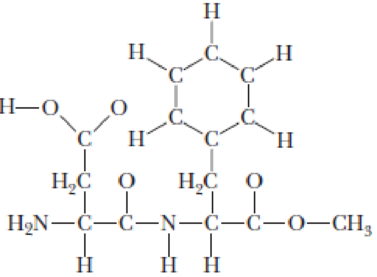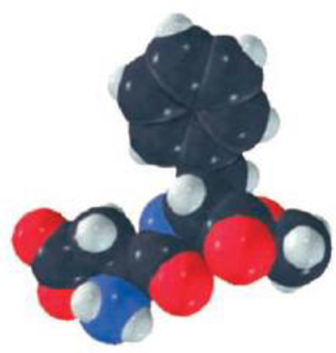
Chemistry: Principles and Practice
3rd Edition
ISBN: 9780534420123
Author: Daniel L. Reger, Scott R. Goode, David W. Ball, Edward Mercer
Publisher: Cengage Learning
expand_more
expand_more
format_list_bulleted
Concept explainers
Textbook Question
Chapter 10, Problem 10.109QE
Aspartame is a compound that is 200 times sweeter than sugar and is used extensively (under the trade name NutraSweet) in diet soft drinks. The skeleton structure of the atoms in aspartame is


- (a) Complete the Lewis structure and give the σ number of and π bonds in aspartame.
- (b) What is the hybridization about each carbon atom that forms a double bond with an oxygen atom?
- (c) What is the hybridization about each nitrogen atom?
Expert Solution & Answer
Want to see the full answer?
Check out a sample textbook solution
Students have asked these similar questions
Don't used hand raiting and don't used Ai solution
Don't used hand raiting and don't used Ai solution
Don't used Ai solution and don't used hand raiting
Chapter 10 Solutions
Chemistry: Principles and Practice
Ch. 10 - Prob. 10.1QECh. 10 - Prob. 10.2QECh. 10 - Prob. 10.3QECh. 10 - Prob. 10.4QECh. 10 - Prob. 10.5QECh. 10 - Prob. 10.6QECh. 10 - Prob. 10.7QECh. 10 - Prob. 10.8QECh. 10 - Prob. 10.9QECh. 10 - Prob. 10.10QE
Ch. 10 - Which atomic orbitals overlap to form the bonds in...Ch. 10 - Prob. 10.12QECh. 10 - Identify the hybrid orbitals used by boron in BCl3...Ch. 10 - Identify the hybrid orbitals used by antimony in...Ch. 10 - Prob. 10.15QECh. 10 - Prob. 10.16QECh. 10 - Prob. 10.17QECh. 10 - Prob. 10.18QECh. 10 - Prob. 10.19QECh. 10 - Prob. 10.20QECh. 10 - Compare and contrast the molecular orbital and...Ch. 10 - Describe the bonding in molecular orbital terms...Ch. 10 - Prob. 10.23QECh. 10 - Prob. 10.24QECh. 10 - Prob. 10.25QECh. 10 - Prob. 10.26QECh. 10 - Prob. 10.27QECh. 10 - Prob. 10.28QECh. 10 - Prob. 10.29QECh. 10 - Prob. 10.30QECh. 10 - Prob. 10.31QECh. 10 - Prob. 10.32QECh. 10 - Prob. 10.33QECh. 10 - Prob. 10.34QECh. 10 - Prob. 10.35QECh. 10 - Prob. 10.36QECh. 10 - Prob. 10.37QECh. 10 - Prob. 10.38QECh. 10 - Prob. 10.39QECh. 10 - Use the VSEPR model to predict the bond angles...Ch. 10 - Prob. 10.41QECh. 10 - Prob. 10.42QECh. 10 - For each of the following molecules, complete the...Ch. 10 - Prob. 10.44QECh. 10 - Prob. 10.45QECh. 10 - Prob. 10.46QECh. 10 - Indicate which molecules are polar and which are...Ch. 10 - Prob. 10.48QECh. 10 - Indicate which of the following molecules are...Ch. 10 - Prob. 10.50QECh. 10 - Prob. 10.51QECh. 10 - Prob. 10.52QECh. 10 - Prob. 10.53QECh. 10 - Prob. 10.54QECh. 10 - Prob. 10.55QECh. 10 - Prob. 10.56QECh. 10 - Prob. 10.57QECh. 10 - Prob. 10.58QECh. 10 - Prob. 10.59QECh. 10 - Prob. 10.60QECh. 10 - Prob. 10.61QECh. 10 - Prob. 10.62QECh. 10 - Prob. 10.63QECh. 10 - Prob. 10.64QECh. 10 - Prob. 10.65QECh. 10 - Prob. 10.66QECh. 10 - Prob. 10.67QECh. 10 - Prob. 10.68QECh. 10 - Prob. 10.69QECh. 10 - Prob. 10.70QECh. 10 - Prob. 10.71QECh. 10 - Prob. 10.72QECh. 10 - Identify the orbitals on each of the atoms that...Ch. 10 - Prob. 10.74QECh. 10 - Prob. 10.75QECh. 10 - How many sigma bonds and how many pi bonds are...Ch. 10 - Give the hybridization of each central atom in the...Ch. 10 - Prob. 10.78QECh. 10 - Prob. 10.79QECh. 10 - Prob. 10.80QECh. 10 - Prob. 10.81QECh. 10 - Predict the hybridization at each central atom in...Ch. 10 - Prob. 10.83QECh. 10 - Tetrafluoroethylene, C2F4, is used to produce...Ch. 10 - Prob. 10.85QECh. 10 - Prob. 10.86QECh. 10 - Prob. 10.87QECh. 10 - Prob. 10.88QECh. 10 - Prob. 10.89QECh. 10 - Prob. 10.90QECh. 10 - Prob. 10.91QECh. 10 - Prob. 10.92QECh. 10 - Prob. 10.93QECh. 10 - Prob. 10.94QECh. 10 - Prob. 10.95QECh. 10 - Prob. 10.96QECh. 10 - Prob. 10.97QECh. 10 - Prob. 10.98QECh. 10 - The molecular orbital diagram of NO shown in...Ch. 10 - The molecular orbital diagram of NO shown in...Ch. 10 - The molecular orbital diagram of NO shown in...Ch. 10 - Prob. 10.102QECh. 10 - Prob. 10.103QECh. 10 - Prob. 10.104QECh. 10 - Prob. 10.105QECh. 10 - Following are the structures of three isomers of...Ch. 10 - The ions ClF2 and ClF2+ have both been observed....Ch. 10 - Aspirin, or acetylsalicylic acid, has the formula...Ch. 10 - Aspartame is a compound that is 200 times sweeter...Ch. 10 - Prob. 10.110QECh. 10 - Prob. 10.111QECh. 10 - Calcium cyanamide, CaNCN, is used both to kill...Ch. 10 - Histidine is an essential amino acid that the body...Ch. 10 - Formamide, HC(O)NH2, is prepared at high pressures...Ch. 10 - Prob. 10.115QECh. 10 - Prob. 10.116QECh. 10 - Prob. 10.117QECh. 10 - Prob. 10.118QECh. 10 - Prob. 10.119QECh. 10 - Prob. 10.120QECh. 10 - Prob. 10.121QECh. 10 - Prob. 10.122QECh. 10 - Prob. 10.123QECh. 10 - Prob. 10.124QECh. 10 - Two compounds have the formula S2F2. Disulfur...Ch. 10 - Prob. 10.126QECh. 10 - Prob. 10.127QE
Knowledge Booster
Learn more about
Need a deep-dive on the concept behind this application? Look no further. Learn more about this topic, chemistry and related others by exploring similar questions and additional content below.Similar questions
- > Organic Functional Groups Naming and drawing alkyl halides structure CI Br CI CI Explanation Check 2 name 1-chloro-2,4,9-trimethylnonane CI 2-iodo-2,3-dimethylbutane FEB 19 € E M tv MacBook Airarrow_forwardCan you please explain to me this problem im very confused and lost. Help me step by step and in detail im soo lost.arrow_forward2) There are many forms of cancer, all of which involve abnormal cell growth. The growth and production of cells, called cell proliferation, is known to involve an enzyme called protein farnesyltransferase (PFTase). It is thought that inhibitors pf PFTase may be useful as anticancer drugs. The following molecule showed moderate activity as a potential PFTase inhibitor. Draw all stereoisomers of this compound. HO OHarrow_forward
- Considering rotation around the bond highlighted in red, draw the Newman projection for the most stable and least stable conformations when viewed down the red bond in the direction of the arrow. Part 1 of 2 H₁₂C H H Draw the Newman projection for the most stable conformation. Select a template to begin. Part 2 of 2 Draw the Newman projection for the least stable conformation. G 心arrow_forwardpersonality of each of them in terms of nucleophile vs. electrophile (some can be considered acids/bases but we are not looking at that here). Note you may have to use your growing intuition to figure out the personality of one of the molecules below but I believe in you! Rationalize it out based on what we have called strong versus weak electrophiles in past mechanisms. Consider using the memes below to help guide your understanding! A OH O B CH3 C Molecule A: [Select] Molecule B: [Select] Molecule C: [Select] Molecule D: [Select] > H D OHarrow_forward4) Which oxygen atom in the structure below is most basic / nucleophilic? Please explain by discussing the electron density around each oxygen atom. Show at least three resonance structures for the compound. оогоarrow_forward
- Can you show me this problem. Turn them into lewis dot structures for me please and then answer the question because I cant seem to comprehend it/ The diagrams on the picture look too small I guess.arrow_forwardThe fire releases 2.80 x 107 Joules of heat energy for each liter of oil burned. The water starts out at 24.5 °C, raising the water's temperature up to 100 °C, and then raises the temperature of the resulting steam up to 325 °C. How many liters of water will be needed to absorb the heat from the fire in this way, for each 1.0 liter of crude oil burned? 4186 J/(kg°C) = heat of water 2020 J/(kg°C) = heat of steam 2,256,000 (i.e. 2.256 x 106) J/kg = latent heat of vaporization for water (at the boiling point of 100 °C).arrow_forward6 Which of the following are likely to be significant resonance structures of a resonance hybrid? Draw another resonance structure for each of the compounds you select as being a resonance form. (A Br: Br: A B C D Earrow_forward
- Write the systematic (IUPAC) name for the following organic molecules. Note for advanced students: you do not need to include any E or Z prefixes in your names. Br structure Br Br Oweuarrow_forwardConservation of mass was discussed in the background. Describe how conservation of mass (actual, not theoretical) could be checked in the experiment performed.arrow_forwardWhat impact would adding twice as much Na2CO3 than required for stoichiometric quantities have on the quantity of product produced? Initial results attachedarrow_forward
arrow_back_ios
SEE MORE QUESTIONS
arrow_forward_ios
Recommended textbooks for you
 Chemistry: Principles and PracticeChemistryISBN:9780534420123Author:Daniel L. Reger, Scott R. Goode, David W. Ball, Edward MercerPublisher:Cengage Learning
Chemistry: Principles and PracticeChemistryISBN:9780534420123Author:Daniel L. Reger, Scott R. Goode, David W. Ball, Edward MercerPublisher:Cengage Learning Chemistry for Engineering StudentsChemistryISBN:9781285199023Author:Lawrence S. Brown, Tom HolmePublisher:Cengage Learning
Chemistry for Engineering StudentsChemistryISBN:9781285199023Author:Lawrence S. Brown, Tom HolmePublisher:Cengage Learning Chemistry: Principles and ReactionsChemistryISBN:9781305079373Author:William L. Masterton, Cecile N. HurleyPublisher:Cengage Learning
Chemistry: Principles and ReactionsChemistryISBN:9781305079373Author:William L. Masterton, Cecile N. HurleyPublisher:Cengage Learning Chemistry for Engineering StudentsChemistryISBN:9781337398909Author:Lawrence S. Brown, Tom HolmePublisher:Cengage Learning
Chemistry for Engineering StudentsChemistryISBN:9781337398909Author:Lawrence S. Brown, Tom HolmePublisher:Cengage Learning
 ChemistryChemistryISBN:9781305957404Author:Steven S. Zumdahl, Susan A. Zumdahl, Donald J. DeCostePublisher:Cengage Learning
ChemistryChemistryISBN:9781305957404Author:Steven S. Zumdahl, Susan A. Zumdahl, Donald J. DeCostePublisher:Cengage Learning

Chemistry: Principles and Practice
Chemistry
ISBN:9780534420123
Author:Daniel L. Reger, Scott R. Goode, David W. Ball, Edward Mercer
Publisher:Cengage Learning

Chemistry for Engineering Students
Chemistry
ISBN:9781285199023
Author:Lawrence S. Brown, Tom Holme
Publisher:Cengage Learning

Chemistry: Principles and Reactions
Chemistry
ISBN:9781305079373
Author:William L. Masterton, Cecile N. Hurley
Publisher:Cengage Learning

Chemistry for Engineering Students
Chemistry
ISBN:9781337398909
Author:Lawrence S. Brown, Tom Holme
Publisher:Cengage Learning


Chemistry
Chemistry
ISBN:9781305957404
Author:Steven S. Zumdahl, Susan A. Zumdahl, Donald J. DeCoste
Publisher:Cengage Learning
Stoichiometry - Chemistry for Massive Creatures: Crash Course Chemistry #6; Author: Crash Course;https://www.youtube.com/watch?v=UL1jmJaUkaQ;License: Standard YouTube License, CC-BY
Bonding (Ionic, Covalent & Metallic) - GCSE Chemistry; Author: Science Shorts;https://www.youtube.com/watch?v=p9MA6Od-zBA;License: Standard YouTube License, CC-BY
General Chemistry 1A. Lecture 12. Two Theories of Bonding.; Author: UCI Open;https://www.youtube.com/watch?v=dLTlL9Z1bh0;License: CC-BY